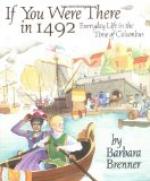Laden with these despatches, Mendez and a Spanish comrade set out along the coast in a canoe manned by six Indians. The party arrived safely at the easternmost Cape of Jamaica (now called Point Morant); but while awaiting calm weather for crossing the strait to Hispaniola, they were attacked by a tribe of savages, who overpowered them by sheer force of numbers, and carried them off as captives. The beads and toys, however, which Mendez had taken with him to barter with the natives, were too attractive not to claim the chief share of the attention of his conquerors; and while they were settling the division of the spoil he managed to effect his escape to his canoe, and to return in it in safety to Santa Gloria. As soon as a second canoe could be procured, Mendez was ready to make a second attempt, but on this occasion he stipulated that he should be accompanied to the easternmost point of Jamaica by a force sufficient to protect him from the hostile tribes. Accordingly, on the 7th July, 1503, the Adelantado, with an armed escort, proceeded along the shore; while Mendez, with six Spaniards and ten Indians, in one canoe, and Fieschi (a Genoese, who had commanded one of the caravels), with a like number in the other, made their way by sea to Point Morant.
After waiting a short time for fine weather, the two canoes started for Hispaniola, and reached a little island called Navazza on the third day, both Spaniards and Indians having suffered terribly from the want of water, with which they were insufficiently supplied. Another day’s labour at the oar brought them to Cape Tiburon, where Mendez left his companions and proceeded alone to St. Domingo. Here he was informed that the governor had left for Xaragua; and thither he made his way alone, through fifty leagues of wild forest country, to represent to Ovando the necessity of sending relief to the admiral, and that speedily. Ovando seems to have temporized. He dreaded the return of Columbus, as likely to excite the seditious to a revolt against his own government. And so far from taking active steps in the matter himself, it was only with reluctance that he authorized Mendez to proceed to St. Domingo to purchase a caravel on behalf of Columbus, in which Fieschi might return to Santa Gloria, and bring him off.
Suspense of the admiral; mutiny of Porras.
Meanwhile, month after month passed by, and the unfortunate castaways at Santa Gloria had no tidings from Hispaniola, and were even ignorant whether their messengers had succeeded in reaching that island. At last, in January, 1504, the murmurs against the inaction of Columbus broke out into open mutiny. Francesco Porras, the captain of one of the caravels, headed the mutineers, and going to the admiral, who was confined to his bed by the gout, told him that he, the admiral, evidently was afraid to return to Spain; but that the people had determined to remain no longer to perish,




